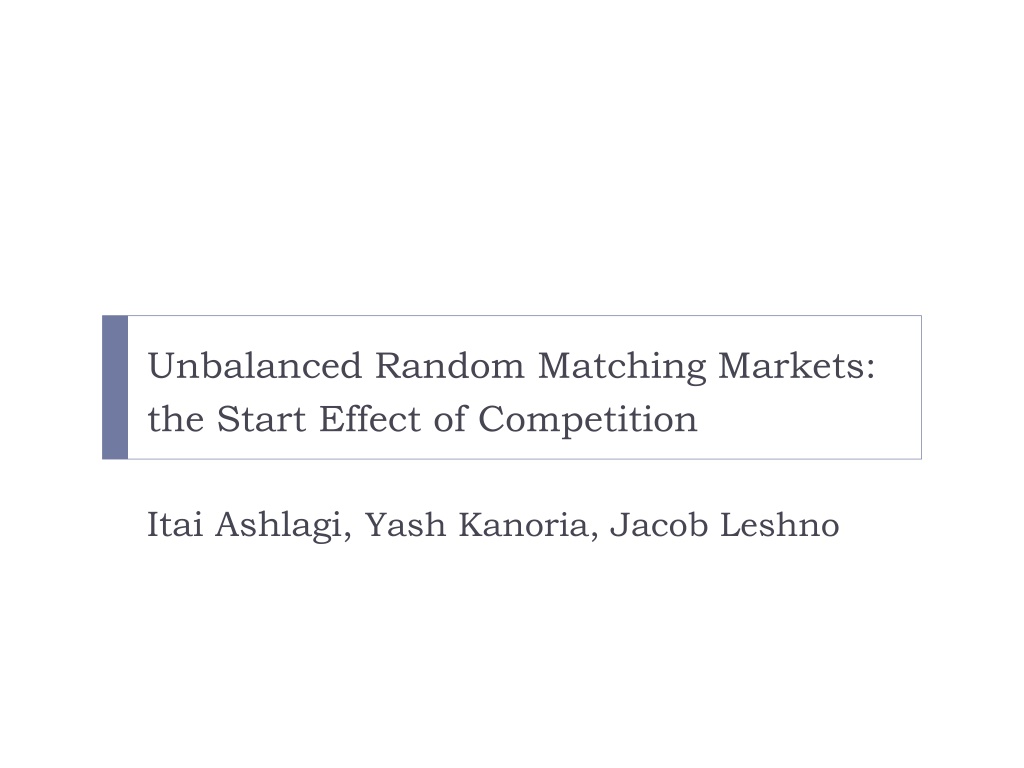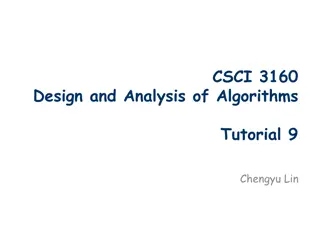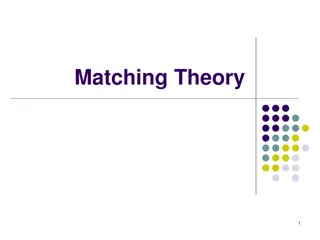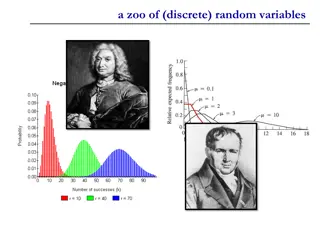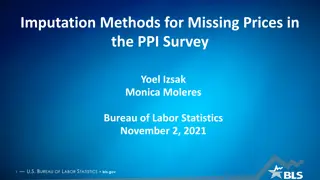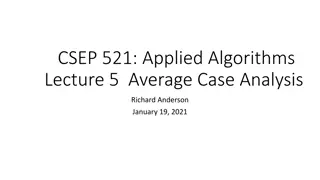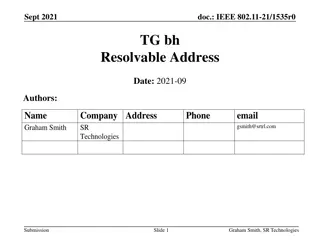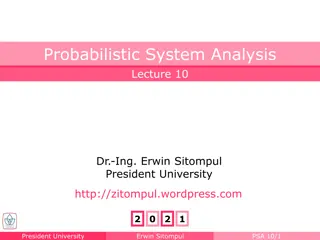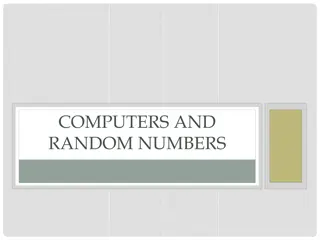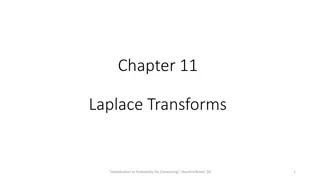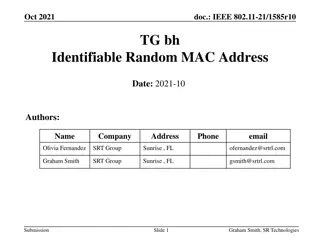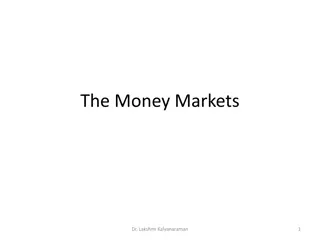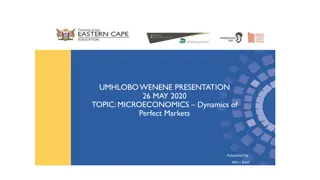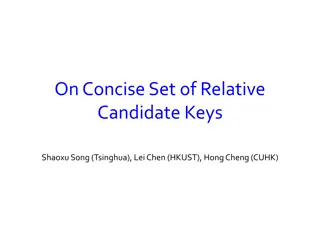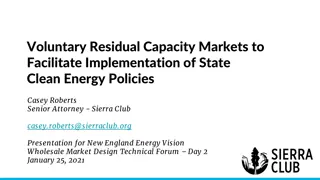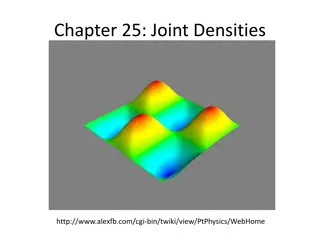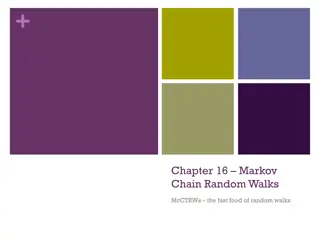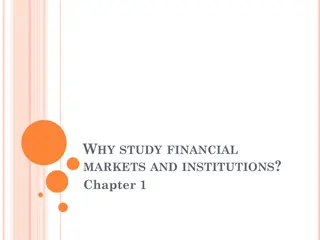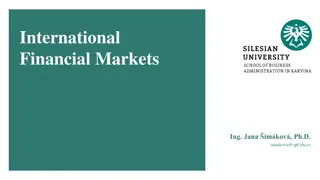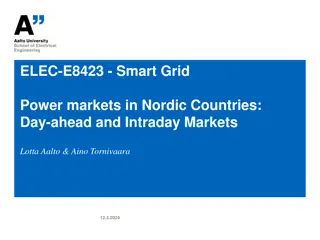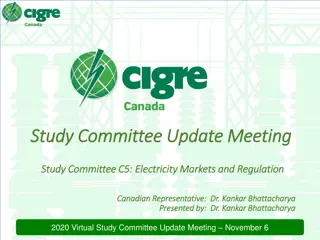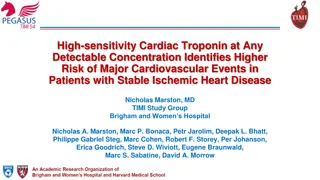Understanding Stable Matching Markets in Unbalanced Random Matching Scenarios
In the realm of two-sided matching markets where individuals possess private preferences, stable matchings are pivotal equilibrium outcomes. This study delves into characterizing stable matchings, offering insights into typical outcomes in centralized markets like medical residency matches and decentralized markets such as online dating. It addresses the significance of stable matchings, the core allocations, and showcases examples to illuminate the concepts discussed.
Download Presentation

Please find below an Image/Link to download the presentation.
The content on the website is provided AS IS for your information and personal use only. It may not be sold, licensed, or shared on other websites without obtaining consent from the author. Download presentation by click this link. If you encounter any issues during the download, it is possible that the publisher has removed the file from their server.
E N D
Presentation Transcript
Unbalanced Random Matching Markets: the Start Effect of Competition Itai Ashlagi, Yash Kanoria, Jacob Leshno
Matching Markets We study two-sided matching markets where Agents have private preferences There are no transfers [Gale & Shapley 1962] Stable matchings are equilibrium outcomes in matching markets. Centralized matching markets: Medical residency match (NRMP), School choice (NYC, Boston, New Orleans, ) Decentralized matching markets: Online dating, labor markets, college admissions This work: characterizing stable matchings What can we say about typical outcomes?
Background: Stable Matchings (Core Allocations) A matching ? is stable if there is no man and woman ?,? who both prefers each other over their current match. The set of stable matchings is a non-empty lattice, whose extreme points are the Men Optimal Stable Match (MOSM) and the Women Optimal Stable Match (WOSM) (Knuth 1976) The WOSM can be computed using the women proposing Deferred Accepted algorithm (Gale & Shapely 1962)
Example The preferences of 3 men and 4 women: A 1 2 3 4 B 2 4 3 1 C 4 1 2 3 1 A B C 2 C A B 3 A C B 4 B C A
Example A non stable matching ( A and 2 would block) A 1 2 3 4 B 2 4 3 1 C 4 1 2 3 1 A B C 2 C A B 3 A C B 4 B C A
Example The MOSM: A 1 2 3 4 B 2 4 3 1 C 4 1 2 3 1 A B C 2 C A B 3 A C B 4 B C A (3 is unmatched)
Example The WOSM: A 1 2 3 4 B 2 4 3 1 C 4 1 2 3 1 A B C 2 C A B 3 A C B 4 B C A (3 is unmatched)
Clearinghouses that find stable matchings Medical Residencies in the U.S. (NRMP) (1952) Abdominal Transplant Surgery (2005) Child & Adolescent Psychiatry (1995) Colon & Rectal Surgery (1984) Combined Musculoskeletal Matching Program (CMMP) Hand Surgery (1990) Medical Specialties Matching Program (MSMP) Cardiovascular Disease (1986) Gastroenterology (1986-1999; rejoined in 2006) Hematology (2006) Hematology/Oncology (2006) Infectious Disease (1986-1990; rejoined in 1994) Oncology (2006) Pulmonary and Critical Medicine (1986) Rheumatology (2005) Minimally Invasive and Gastrointestinal Surgery (2003) Obstetrics/Gynecology Reproductive Endocrinology (1991) Gynecologic Oncology (1993) Maternal-Fetal Medicine (1994) Female Pelvic Medicine & Reconstructive Surgery (2001) Ophthalmic Plastic & Reconstructive Surgery (1991) Pediatric Cardiology (1999) Pediatric Critical Care Medicine (2000) Pediatric Emergency Medicine (1994) Pediatric Hematology/Oncology (2001) Pediatric Rheumatology (2004) Pediatric Surgery (1992) Primary Care Sports Medicine (1994) Radiology Interventional Radiology (2002) Neuroradiology (2001) Pediatric Radiology (2003) Surgical Critical Care (2004) Thoracic Surgery (1988) Vascular Surgery (1988) Postdoctoral Dental Residencies in the United States Oral and Maxillofacial Surgery (1985) General Practice Residency (1986) Advanced Education in General Dentistry (1986) Pediatric Dentistry (1989) Orthodontics (1996) Psychology Internships (1999) Neuropsychology Residencies in the U.S. & CA (2001) Osteopathic Internships in the U.S. (before 1995) Pharmacy Practice Residencies in the U.S. (1994) Articling Positions with Law Firms in Alberta, CA(1993) Medical Residencies in CA (CaRMS) (before 1970) British (medical) house officer positions Edinburgh (1969) Cardiff (197x) New York City High Schools (2003) Boston Public Schools (2006), Denver, New Orleans 8
This Paper So far theory does not explain the success of centralized markets Theorem [Roth 1982]: No stable mechanism is strategyproof Theorem [Demange, Gale, Sotomayor (1987)]: Agents can successfully manipulate if only if they have multiple stable partners This paper provides an explanation for why stable matchings are essentially unique.
Random Matching Markets Hard to give general characterizations Examples exist where the core is large or small, stable outcomes good or bad for women Random Matching Market: A set of ? men and a set of ? + ? women ? Man ? has complete preferences over women, drawn randomly at uniform iid. Woman ? has complete preferences over men, drawn randomly at uniform iid. Goal: characterization of typical outcomes in random markets with varying imbalance and hence competition.
Questions How many agents have multiple stable assignments? Demange, Gale, Sotomayor (1987): Agents can manipulate if only if they have multiple stable partners. Average rank for each side Define men s average rank of their wives under ? 1 ?Men ? Rank?? ? ? 1? ? ? 1? excluding unmatched men from the average Average rank is 1 if all men got their most preferred wife, higher rank is worse.
Large core in balanced random markets Theorem [Pittel 1998, Knuth, Motwani, Pittel 1990]: In a random market with ? men and ? women, with high probability: The core is large: the fraction of agents that have multiple stable partners tends to 1 as ? tends to infinity. 1. How large is the core when there n men and n+1 women? The average ranks in the WOSM are 2. ?Women= log ? and ? ?men= What is the average rank of women in the WOSM? log? ?=1000, log ?= 6.9, ?/log ?=145 ?=100000, log ?=11.5, ?/log ?=8695
Related literature All documented evidence shows the core is small: Roth, Peranson (1999) small core in the NRMP Hitsch, Hortascu, Ariely (2010) small core in online dating Banerjee et al. (2009) small core in Indian marriage markets We can explain small cores in restricted settings: Immorlica, Mahdian (2005) and Kojima, Pathak (2009) show that if one side has short random preference lists the core is small But many agents are unmatched Small core when preferences are highly correlated (e.g., Holzman, Samet (2013)) Comparative statics on adding men but only in a given extreme stable matching, Crawford (1991)
Results unbalanced markets When there are unequal number of men and women: The core is small; small difference between the MOSM and the WOSM Small core despite long lists and uncorrelated preferences The short side is much better off under all stable matchings; roughly, the short side chooses and the long side gets chosen sharp effect of competition Out results suggest that real matching markets will have an essentially unique stable matching
Percent of matched men with multiple stable partners ? = 40 100 percent of matched men with 90 multiple stable partners 80 70 60 50 40 30 20 10 0 20 22 24 26 28 30 32 34 36 38 40 42 44 46 48 50 52 54 56 58 60 Number of men
Mens average rank of wives, ? = 40 18 16 Men's average rank of wives 14 12 10 10~40/log(40) MOSM WOSM 8 6 4 4~log(40) 2 0 20 22 24 26 28 30 32 34 36 38 40 42 44 46 48 50 52 54 56 58 60 Number of men
Mens average rank of wives, ? = 40 18 16 Men's average rank of wives 14 12 10 MOSM WOSM 8 6 4 2 0 20 22 24 26 28 30 32 34 36 38 40 42 44 46 48 50 52 54 56 58 60 Number of men
Mens average rank of wives, ? = 40 18 16 Men's average rank of wives 14 12 10 MOSM WOSM 8 6 4 2 0 20 22 24 26 28 30 32 34 36 38 40 42 44 46 48 50 52 54 56 58 60 Number of men
Mens average rank of wives, ? = 40 18 16 Men's average rank of wives 14 12 MOSM WOSM RSD 10 8 6 4 2 0 20 22 24 26 28 30 32 34 36 38 40 42 44 46 48 50 52 54 56 58 60 Number of men
Theorem 2: One woman makes a difference In a random market with ? men and ? + 1 women, with high probability in all stable matchings: ?Men 1.01 log ? and ? ?Women 1.01 log? Moreover, ?MenWOSM (1 + ?(1))?Men(MOSM) ?Women(WOSM) (1 ?(1))?Women(MOSM)
Theorem 2 (for any k) Consider a random market with ? men and ? + ? women, for ? = ? ? 1. With high probability in any stable matching ?Men 1.01? + ? ? + ? ? log ? and ? ?Women 1 + 1.01? + ? log? + ? ? ? Moreover, ?MenWOSM (1 + ?(1))?Men(MOSM) ?Women(WOSM) (1 ?(1))?Women(MOSM)
Theorem 2 That is, with high probability under all stable matchings when the men are on the short side Men do almost as well as they would if they chose, ignoring women s preferences. Women are either unmatched or roughly getting a randomly assigned man.
Large imbalance Theorem: Consider a random market with ? men and (1 + ?)? women for ? > 0. Let ? = 1.01 (1 + ?) log (1 +1 ?) we have that, with high probability, in all stable matchings ?Men ? and ? ?Women 1 + ? Follows also from Ashlagi, Braverman, Hassidim (2011)
Intuition In a competitive assignment market with ? homogenous buyers and ? homogenous sellers the core is large, but the core shrinks when there is one extra seller. In a matching market the addition of an extra woman makes all men better off Every man has the option of matching with the single woman But only some men like the single woman Changing the allocation of some men requires changing the allocation of many men: If some men are made better, some women are made worse off, creating more options for other men. All men benefit, and the core is small.
Proof overview Calculate the WOSM using: Algorithm 1: Men-proposing Deferred Acceptance gives MOSM Algorithm 2: MOSM WOSM Both algorithms use a sequence of proposals by men Stochastic analysis by sequential revelation of preferences.
Men-proposing Deferred Acceptance (Gale & Shapley) Everyone starts unmatched. Repeat until all men are matched: Each rejected or unmatched man proposes to his most preferred woman he has yet proposed to. Each woman who receives at least one proposal, rejects all but her most preferred proposal so far.
Algorithm 2: MOSM WOSM We look for stable improvement cycles for women. Iterate: Phase: For candidate woman ?, reject her match ?, starting a chain. Two possibilities for how the chain ends: (Improvement phase) Chain reaches ? new stable match. (Terminal phase) Chain ends with unmatched woman ? is ? s best stable match. ? is no longer a candidate. [same women who are unmatched in all stable matchings]
Illustration of Algorithm 2: MOSM WOSM ?1 ?2 ?1 ?2 ?2 prefers ?1 to ?2 ?1 rejects ?1 to start a chain
Illustration of Algorithm 2: MOSM WOSM ?3 ?1 ?2 ?1 ?2 ?3 ?2 prefers ?1 to ?2
Illustration of Algorithm 2: MOSM WOSM ?3 ?1 ?2 ?1 ?2 ?3
Illustration of Algorithm 2: MOSM WOSM ?3 ?1 ?2 ?1 ?2 ?3 ?1 prefers ?3 to ?1
Illustration of Algorithm 2: MOSM WOSM ?3 ?1 ?2 ?1 ?2 ?3 New stable match found. Update match and continue.
Illustration of Algorithm 2: MOSM WOSM ?1 ?4 ?3 ?4 ?1 rejects ?3 to start a chain ?4 prefers ?3 to ?4
Illustration of Algorithm 2: MOSM WOSM ?5 ?1 ?4 ?3 ?4 ?5 ?5 prefers ?4 to ?5
Illustration of Algorithm 2: MOSM WOSM ?5 ?1 ?4 ? ?3 ?4 ?5 Chain ends with a proposal to unmatched woman ? ?3 is ?1 s best stable partner and similarly ?4 and ?5 already had their best stable partner
Illustration of Algorithm 2: MOSM WOSM ?5 ?1 ?4 ? ?3 ?4 ?5 Chain ends with a proposal to unmatched woman ? ?3 is ?1 s best stable partner and similarly ?4 and ?5 already had their best stable partner
Illustration of Algorithm 2: MOSM WOSM women who found their best stable partner ?5 ?1 ?4 ? ?3 ?4 ?5 Chain ends with a proposal to unmatched woman ? ?3 is ?1 s best stable partner and similarly ?4 and ?5 already had their best stable partner
Illustration of Algorithm 2: MOSM WOSM ?5 ?1 ?4 ? ?3 ?4 ?5
Illustration of Algorithm 2: MOSM WOSM ?5 ?1 ?4 ? ?3 ?4 ?5 ?8 ?8 rejects ?8 to start a new chain ?8
Illustration of Algorithm 2: MOSM WOSM ?5 ?1 ?4 ? ?3 ?4 ?5 ?8 ?4 prefers ?8 to ?4 But ?4 is already matched to her best stable partner ?8
Illustration of Algorithm 2: MOSM WOSM ?5 ?1 ?4 ? ?3 ?4 ?5 ?8 ?4 prefers ?8 to ?4 But ?4 is already matched to her best stable partner ?8 is ?8 s best stable partner ?8
Illustration of Algorithm 2: MOSM WOSM ?5 ?1 ?4 ? ?3 ?4 ?5 ?8 ?4 prefers ?8 to ?4 But ?4 is already matched to her best stable partner ?8 is ?8 s best stable partner ?8
Proof idea: Analysis of men-proposing DA is similar to that of Pittel (1989) Coupon collectors problem Analysis of Algorithm 2: MOSM WOSM more involved. Track S - set of woman matched already to best stable partner Once S is large improvement phases are rare Together, in a typical market, very few agents participate in improvement cycles
Further questions Can we allow correlation in preferences? Perfect correlation leads to a unique core. But short side depends on more than ?,? Tiered market: 30 doctors, 40 medical programs: 20 top, 20 low What is a general balance condition?
Correlation - ??? = ? ? + ? 18 6% 16 5% Men's Average Rank of Wives 14 MOSM 12 4% WOSM 10 RSD 3% 8 Pct Multiple Stable 6 2% 4 1% 2 0 0% 0 2 4 6 8 10 12 14 16 18 20 22 24 26 28 30 32 34 36 38 40 Correlation in Men's preferences - (N+K) ? = 30 ? = 10
Percent of men with multiple stable matches Diff: -10 -1 0 +1 +5 +10 ? 100 2.1 15.1 75.3 15.4 4.5 2.3 200 2.2 14.6 83.6 14.6 4.1 2.1 500 2.0 12.6 91.0 13.1 3.6 2.0 1000 1.9 12.3 94.5 12.2 3.4 2.0 2000 1.8 11.1 96.7 11.1 2.9 1.7 5000 1.5 10.1 98.4 10.2 2.8 1.5
Conclusion Random unbalanced matching markets are highly competitive: Essentially a unique stable matching The short side is highly favored and gets to choose Results suggest that every matching market has a small core Clearinghouses that implement stable outcomes make it safe for all agents to reveal their information! Remark: in order to find an optimal allocation, one can focus on the set of feasible matchings (or on choice menus)
